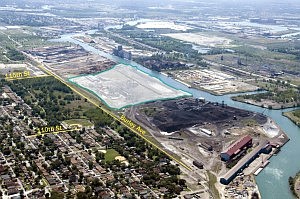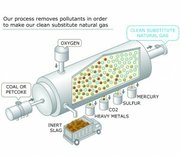Editorial: Proposed Energy Facility brings reform
Senate Bill 1533 recently passed in both houses of the Illinois General Assembly with overwhelming majorities. The legislation backs the proposal for a $ 3 billion clean energy facility on Chicagos Southeast side. Sponsored by Representative Marlow H. Colvin and Senator Donne E. Trotter, the bills fate now rests with Governor Pat Quinn. The project will provide Illinois ratepayers relief from high gas prices by manufacturing a substitute natural gas from coal and petroleum coke.
Chicago Clean Energy is an initiative of Leucadia National Corporation that supports the $ 3 billion investment in green technology on the Southeast side of Chicago. The gasification facility will be located on 115th St and Burley Avenue and will produce substitute natural gas through the cleanest method of utilizing Illinois coal anywhere in the world.
SB 1533 provides a long-term financing mechanism that enables the construction of the Chicago Clean Energy facility and allows the sale of natural gas to Illinois gas utilities over the next 30 years. Under the legislation, state gas utilities Nicor, Peoples, North Shore and Ameren would be mandated to enter into agreements with the facility for approximately five percent of the utilities supply.
Chicago Clean Energy says it would sell 43.5 billion cubic feet of substitute natural gas annually to gas utilities for 30 years, at a price set by formula, with consumer protection provided by a Consumer Protection Reserve Account, Illinois Power Agency and Illinois Commerce Commission oversight, and a $100 million Guaranteed Savings provision.
Governor Quinn has approximately 60 days to sign SB 1533 into law. There are several reasons we think the Governor should sign the legislation. The bill carries enormous benefits for the environment, economy, and job market.
Environmentally, the gasification process used at the facility is a cleaner process than conventional coal plants, as there is no burning of coal or petroleum coke. The gasification process captures impurities on the front-end, instead of emitting them as pollution on the back end, and is over 99% cleaner than conventional uses of the same fuels. The process captures and sequesters 85 percent of the carbon dioxide emitted, which is the highest mandated level of sequestration in the nation.
Gasification is an environmentally sound way to convert any carbon-based material, such as coal, refinery byproducts, or biomass, into energy without burning it. The process converts these organic or fossil-based materials into carbon monoxide, hydrogen, carbon dioxide and methane. This process is achieved by reacting the material at high temperatures, without combustion, with a controlled amount of oxygen and/or steam. The resulting gas mixture is cleaned of impurities, and then further processed into substitute natural gas, which is indistinguishable from the natural gas used routinely in the U.S. as a clean energy source.
Economically, the Chicago Clean Energy plant will create tens of thousands of local jobs and generate more than $1 billion in local tax revenue. The project is privately financed which will generate over $10 billion in economic output for Illinois. Tax dollars are not used and Chicagos Southeast side and Illinois receives $3 billion in private investment.
Additionally, tens of thousands of jobs will be created and an estimated $1.25 billion will be added in state and local tax revenue, according to Chicago Clean Energy.
Jobs play a huge role in Chicago Clean Energy.
During construction of the facility, a daily average of 1,100 jobs and an additional 626 jobs in local and related businesses will be available. Once the site is operational, 200 permanent high-paying jobs and an additional 460 jobs in local related businesses will be available. 165 mining jobs and 259 jobs in local and related businesses in the coal industry will also be established.
Chicago Clean Energy will also bring job training programs to the area.
Because gasification is a new technology in Illinois and across the nation, many workers have not been trained in the field. As a result, job training programs are proposed as part of the project. Local workers on the Southeast Side would be encouraged to participate. Representative Colvin and Senator Trotter are highly supportive of the job training programs and resulting jobs for the community, the Chicago Clean Energy project cites.
Consumer savings and protections also play a significant role in the project.
Consumers receive several savings and protections with Chicago Clean Energy. Protections include Illinois taxpayers are not held accountable for financing, developing, constructing or operating the facility. Instead, the developer bears all the risk for cost over-runs and delays. Ratepayers are guaranteed to save $100 million on natural gas bills and expected to save more than $1 billion over 30 years.
We think Chicago Clean Energy will make the city's Southeast side a green technology frontier where Illinois can become a leader in the clean energy field. In addition, Chicago has lost thousands of jobs in recent years and the Leucadia Project will bring meaningful employment back to the city. Moreover, it will increase the demand for coal throughout the state leading to hundreds more jobs for coal mines in central and southern Illinois. Because its an overall good project for Illinois, we hope the governor will sign the legislation into law.
Latest Stories
- ICYMI: Midwest Democratic Leaders Emphasize Party Strength and Unity Ahead of 2024 Democratic National Convention
- West Side Young Men Travel to the State Capitol to Advocate for a new Department for Early Childhood and the Austin People’s Action Center’s Freedom School
- Comcast Launches NOW – a New Brand and Product Portfolio that Redefines Low-Cost Internet, Mobile, and TV
- Wards365 Announces Summer50 Fest on Saturday, May 18 at United Center City-Wide Resource Festival focused on Summer Activities for Youth and Families
- The Magic Of Alvin Ailey Comes To The Auditorium Theater
- BOSS Impact Funds Gives Black Women Entrepreneurs Access To Capital
- Closing the Black Maternal Health Gap Is At The Center Of Organization’s Work
- Praize Productions’ Production Shows That ‘Black Love Reigns Supreme’
- Chicago Public Schools Announces 2024-25 Preschool Application Launch
- State Treasurer Michael Frerichs Pushes to Reunite Residents with Unclaimed Property, Missing Money
Latest Podcast
Sydney Blaylock-The local skater with national experience




